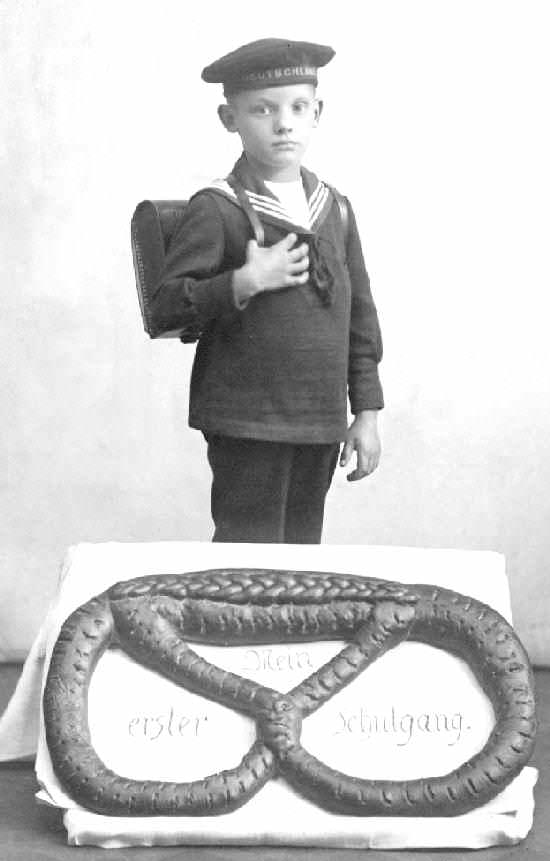
Geman School Clothes: First Day--Pretzel

Figure 1.--This German boy was photographed with a bread or ptretzel symbol at the bottom. The inscription reads, "Mein erster Schulgang", (My first schoolday.). Apparently he did not get a Zuckertute or gift cone which must have been a disappoinment.
|
Some boys were photographed with a good luck bread or pretzel. This was much less common than the cone or "Zuckertute". Perhaps these boys did not get a cone, which must have been disappointing as they contained so many goodies. We are not precisely sure just what the symbolism was for the pretzel. The inscription "Mein erster Schulgang" certainly shows that it was a first day of school portrait. Hopefully our German readers can provide some insightful background here.
The Pretzel
A German reader tells us, "I don't know what the meaning of the pretzel was, but I do know, that in some regions it was/is common to present on first school day a pretzel (German: Brezel) to the child beginning school. The Brezel shown in the portrait looks rather large (figure 1). Like a Silvesterbrezel, that is bought on Silvester (December 31) and eaten during the evening. Moreover, the kind of pasty looks more
like it is made in the Bavarian style. Bavarian Brezeln are usually smaller and don't have salt coins and natrone acid on them. In our region (Swabia) the Brezeln are usually smaller, too and dipped into Brezellauge (a kind of Natrone acid) and baked, thus becoming brown, then there are usually bits of salt on it. The "bauchy" part is left white. "Bauchy" meant the part where the Brezel becomes broader and usually softer than at its arms (Brezel comes possibly from latin braccium meaning arm). This broader part is usually white.
People use to slice the Brezel at this part and eat it with butter on it , or put the butter on its
back. But the first way is more common. There are several towns that claim to have invented the Brezel in Germany. It was more common to receive a Schultüte (HBC uses Zuckertüte for it, a term I'm less familiar with, but it's also used.) These Schultüten are common since the late 19th century, they first were hanged on Christmas trees, besides other equipment, later they were used as special present to sweeten the first day at school. In the town of Nürtingen,
Baden-Württemberg the children receive a small amount of money and two Brezeln, too. This day is called Maientag, held usually in May. They received it at first on first school day I believe. The people are woken up by horns and a youth band. Then the major receives bread and salt, with wishes, that these won't end in our town. There are bands, costumed parades, in which school children take part. And later a fair with competitions. It's a kind of National day of town. I believe the first day Brezeln are connected with similar wishes, but I'm not yet sure."
Reader Comment
The megapretzel in the photograph looks like a photographer's prop, like those candles with fake flames in the first communion photos. It's fascinating to learn about the traditions behind these things. Seen in isolation the picture with the big pretzel just seems surreal, but once we learn the context this artifact from long ago and far away becomes more familiar and understandable. Thanks.
HBC Comment
HBC is very grateful for the background information our German readers provide us. Of course Americans have a wide variety of experiences, depending on their ethnic background, educarion, and travel. Many Americans know a good bit about Britain, but even though the Germans are a major component of the American melting pot, these Germans customs such as the pretzel here amd the Zuckertüte are virtually unknown to Americans. Our only connection of pretzels with Germany is at Octoberfests.
Christopher Wagner

Related Chronolgy Pages in the Boys' Historical Web Site
[Main Chronology Page]
[The 1880s]
[The 1890s]
[The 1900s]
[The 1910s]
[The 1920s]
[The 1930s]
[The 1940s]
[The 1950s]
[The 1960s]
[The 1970s]
[The 1980s]
Related Style Pages in the Boys' Historical Web Site
[Main school uniform page]
[Main country page]
[Long pants suits]
[Short pants suits]
[Socks]
[Eton suits]
[Jacket and trousers]
[Blazer
[School sandals]
Navigate the Boys' Historical Clothing School Uniform Pages
[Return to the Main German first school day page]
[Return to the Main School Uniform Page]
[Australia]
[England]
[France]
[Germany]
[Italy]
[Japan]
[New Zealand]
[Scotland]
[United States]
Navigate the Boys' Historical Clothing Web Page
[Introduction]
[Activities]
[Biographies]
[Chronology]
[Clothing styles]
[Countries]
[Bibliographies]
[Contributions]
[FAQs]
[Glossary]
[Satellite site]
[Tools]
[Boys' Clothing Home]
Created: November 13, 2002
Last updated: November 13, 2002



